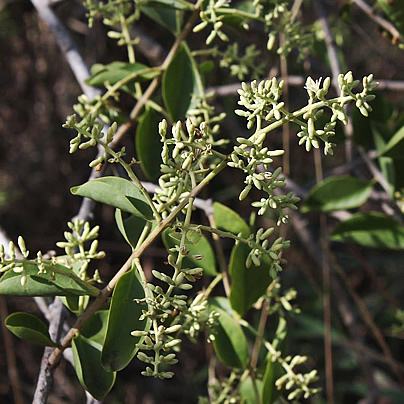The mistletoe (Struthanthus sp) is a genus of parasitic plants, belonging to the Loranthaceae family, and one of the most common genera in the Tropical Americas, affecting various types of host trees, both in urban and rural environments. Although the name “mistletoe” encompasses different species of parasitic herbs from various genera and families, it will be used in this article to refer to the genus Struthanthus, for practical and didactic purposes, as this is one of the most common genera affecting plants in gardens.
Its dispersion occurs through birds, which ingest the fruits of the plants and excrete or regurgitate the seeds onto host trees. As soon as they germinate, the seeds emit a special type of root called a haustorium, a structure capable of invading the vascular tissues of other plant species and extracting raw and elaborated sap. The mistletoe is considered an epiparasite, as it is usually found on the branches of trees and shrubs, and a hemiparasite because it can photosynthesize, meeting about 60% of its energy needs from the hosts.
The specific mistletoe in question has thin, long, and flagelliform branches that envelop the branches and trunk of the host plant and emit new roots at intervals. With these long branches, they can also affect neighboring trees near the initial host. It has oblong-oval, alternate, leathery, and shiny leaves. The flowers are small, discreet, hermaphroditic, light green to cream in color, and the subsequent fruits are small, globular to ellipsoidal, orange or yellow berries, with one or two seeds. The fruit pulp is sticky, facilitating the adhesion of the seeds to the host’s branches. The fruits are eagerly consumed by birds.

Mistletoe entwining the host’s branches. Photo by Mauricio Mercadante.
As the mistletoe develops, the host plant gradually weakens, suffocated by shading and the theft of water and nutrients. If it is a fruit-bearing plant, it loses productivity and fruit quality. It often affects citrus trees in general, such as orange trees and lemon trees, as well as peach trees, mango trees, apple trees, oleanders, casuarinas, cypresses, bougainvilleas, azaleas, and tipuanas. The branches become weak and susceptible to breakage and attacks by pests and diseases. The tree or shrub goes into decline, inevitably leading to premature death if not treated in time.
Controlling mistletoe is quite difficult, as the removal of the parasitic plant is entirely manual, involving the removal of each branch that is on the host plant. Even so, there is always a great chance of regrowth in all places where viable roots may have remained.
Often, a deeper scraping or pruning may be necessary for the removal of the parasite. Mistletoe has a great ability to regenerate if viable roots remain on the host; therefore, removal work must be careful. Ideally, always identify the mistletoe early when it is easier to clean the plants, and they have not suffered considerable damage yet.

